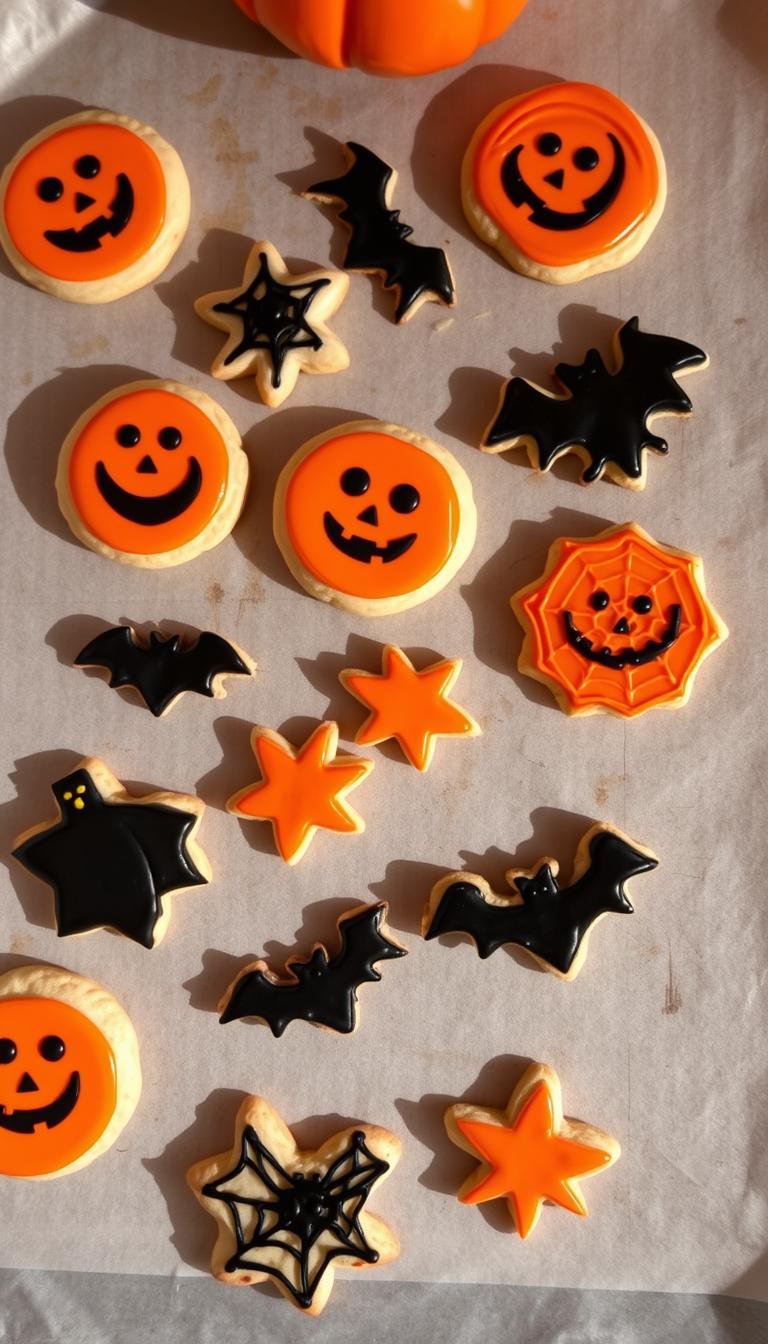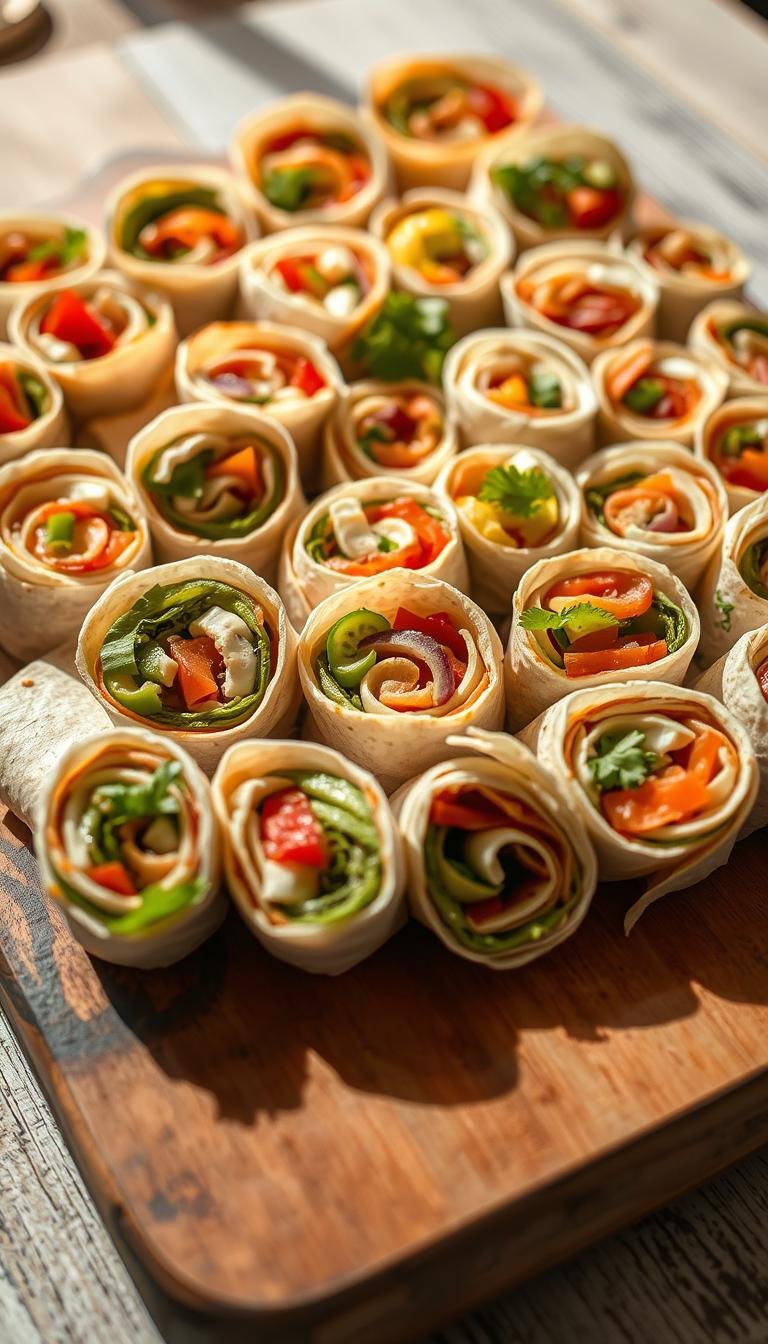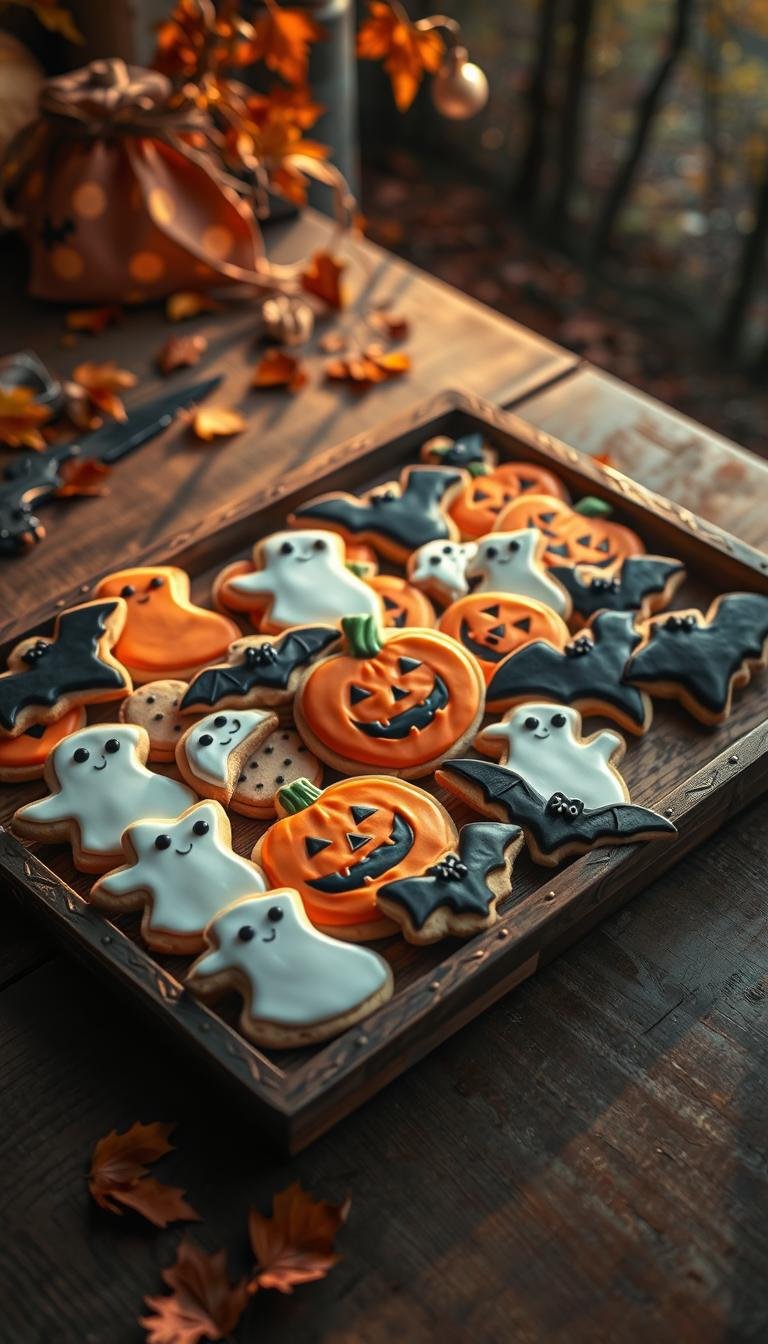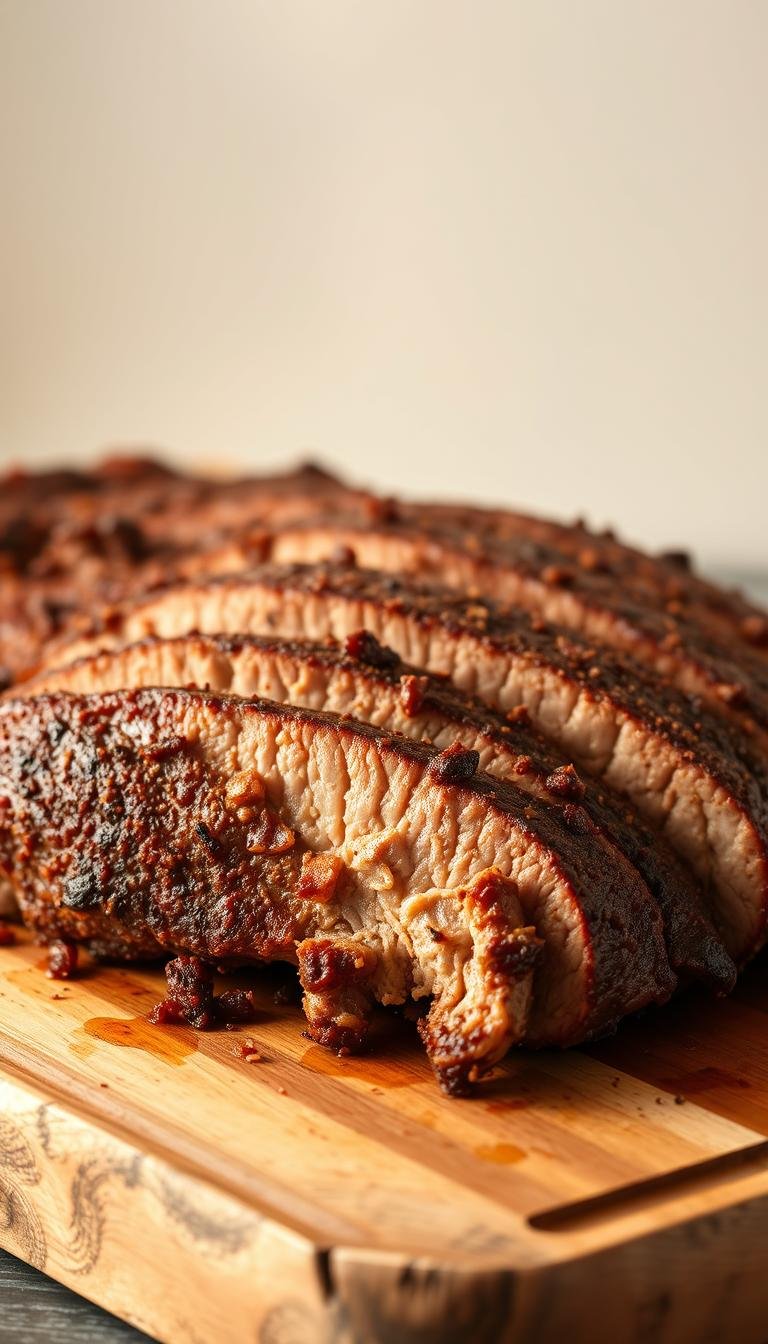Easy Halloween Cookies Recipe for This Halloween
One in three home bakers say seasonal treats drive them to plan weeks ahead — and with good reason.
This post groups three reliable cookie styles that make holiday baking fast and fun: chewy drop cookies studded with M&M-style candy and jimmies, crisp no-spread cut-outs that hold sharp shapes, and colorful slice-and-bake pinwheels that wow a crowd.
Drop batches bake at 350°F for about 12 minutes; chilling the dough gives extra chew. No-spread sugar cookie rounds roll 1/4–1/2 inch thick and need 7–11 minutes at 350°F. Pinwheel logs chill, then bake at 325°F for 13–15 minutes once sliced.
Small tips matter: choose jimmies or confetti sprinkles to avoid color bleed, press candy eyes onto warm cookies, and use gel colors so dough texture stays steady. Store drop cookies airtight up to five days; freeze sugar cookies and dough logs to save time later.
Key Takeaways
- Three go-to styles: M&M drop, no-spread sugar cut-outs, and pinwheel slices.
- Chill dough for chewiness; bake times: 350°F (~7–12 min) and 325°F (13–15 min).
- Use jimmies/confetti sprinkles and gel colors to protect designs.
- Press candy eyes on warm cookies; they stick best right after baking.
- Store drops 5 days; freeze sugar cookies 3 months; freeze pinwheel logs 1–2 months.
Why You’ll Love These Easy Halloween Cookies
Choose a cookie style and you can have festive trays out of the oven in under an hour of active time. These recipes use pantry basics and a few reliable steps so even busy cooks finish on schedule.
Kid-friendly, party-ready, and fast to bake. Kids can mix, press candy on warm tops, or shake sprinkles while adults handle dough chilling and oven work.
Choose your style
Chewy M&M mix-ins: a chocolate-chip base with candy and sprinkles that stays soft when chilled.
No-spread cut-outs: roll to 1/4–1/2 inch; bake 7–11 minutes at 350°F for crisp edges that hold royal icing.
Pinwheel swirls: color two dough halves with gel, chill the log, then slice and bake at 325°F for 13–15 minutes.
| Style | Active time | Bake temp | Best for |
|---|---|---|---|
| Chewy drops | 20–30 min | 350°F | Kids, quick trays |
| Sugar cut-outs | 30–45 min | 350°F | Decorating, parties |
| Pinwheels | 40–50 min | 325°F | Eye-catching platters |
Ingredients & Simple Substitutions
Start with basic pantry items, then choose swaps that keep flavor and texture intact.
Pantry basics
Flour, sugar, baking powder or soda, and salt make the backbone of every batch. Use all-purpose flour for structure; for drop dough, add 1 tsp cornstarch to tenderize.
Fats and flavor
Choose unsalted butter and control salt. For creaming methods, bring butter and eggs to room temperature so a mixer blends them smoothly.
Vanilla (about 2 tsp) rounds the flavor. For drop cookies, melted and slightly cooled butter speeds mixing; for sugar cookies, cream butter sugar for the best texture.
Festive add-ins
Add about 1 cup Halloween M&M’s or 1/4 cup sprinkles to drop dough. Use gel food coloring for pinwheel layers to avoid changing dough moisture.
- Measure by cup: 2 1/4 cups flour for drops; 3 cups flour for sugar cookies.
- If sugar cookies feel dry, add water 1 tsp at a time; if wet, add flour 1 tsp at a time.
- Press candy eyes onto warm cookies after baking so they stick.
Tools You’ll Need
Having the right gear keeps dough handling quick and stress-free. Gather a short list of reliable items so baking moves smoothly from mixing to the oven.
Mixing and prep
Use a stand mixer or a hand mixer to cream butter and sugar for a light texture. Keep one large bowl and one medium bowl ready to separate wet and dry parts.
A sturdy silicone spatula folds in mix-ins and prevents breakage while a set of measuring cups ensures accurate flour and sugar amounts.
Shaping and chilling
For no-spread shapes, roll the dough 1/4–1/2 inch on a lightly floured surface. Have a rolling pin, cookie cutters, and plastic wrap to form and chill logs cleanly.
Baking and cooling
Line a baking sheet or cookie sheet with parchment paper to stop sticking and to promote even browning. Keep an extra sheet so dough always goes on a cool surface.
Preheat the oven and place racks in the center. A wire rack speeds cooling and keeps crisp edges on every cookie.
| Tool | Why it matters | Quick tip |
|---|---|---|
| Stand mixer / mixer | Creams butter and sugar evenly | Use medium speed for 2–3 minutes |
| Baking sheet / cookie sheet | Even bake and browning | Line with parchment for clean release |
| Rolling pin & cookie cutters | Sharp shapes and uniform thickness | Chill dough briefly before cutting |
| Wire rack | Prevents steaming and soggy edges | Cool cookies 5–10 minutes off the sheet |
Step-by-Step: From Dough to Spooky Treats
Good structure begins in the mixer. Use a bowl and a stand mixer or hand mixer to cream butter and sugar for 2–4 minutes until pale and fluffy, scraping the sides as you go. Add eggs and vanilla, mixing just until combined so the emulsion stays light.
Whisk the dry ingredients—flour, leaveners, and salt—then add them on low speed. Stop once the dough comes together; overmixing makes tough results. For M&M-style drop dough, melt butter and beat with sugars about 4 minutes before adding the egg and yolk.
Chill, shape, and bake
- Chill vs. no-chill: Chill drop dough at least 2 hours or overnight to limit spread. No-spread sugar dough can be rolled and baked at 350°F right away for 7–11 minutes.
- Shape: Scoop-and-bake for drops, roll-and-cut for shapes, or slice-and-bake for pinwheels after a 1-hour log chill.
- Bake & cool: Use the right oven temp—350°F for drops and cut-outs, 325°F for pinwheels. Bake until edges are set; cool on the sheet a few minutes, then move to a rack to finish.
Pro tip: Press candy eyes or a few extras onto warm tops so they stick and look bakery-fresh.
Decorating & Toppings That Scream Halloween
Decorating is where simple dough becomes a themed tray everyone remembers. Choose a finish first, then pick tools and small accents that will hold up on the table.
Royal icing vs. crusting vanilla buttercream
Royal icing dries hard and is ideal for crisp outlines and flood work. It is best for delicate line work and stacked displays.
Crusting vanilla buttercream sets with a thin skin and tastes rich. It’s faster to whip and perfect for sugar cookies when you want soft texture and simple rosettes.
Sprinkles, candy eyes, and color-safe choices
Use jimmies or confetti sprinkles to avoid color bleed. Press small candy eyes onto warm tops right after baking so they stick without extra glue.
Place sprinkles onto freshly frosted cookies or gently press them onto warm drop cookies so they anchor well.
Palette and finishing tips
- Build a palette with gel colors: orange, purple, and green; add a touch of black for contrast.
- Balance sweetness: pair lightly sweet sugar cookies with tangy glaze or bright vanilla frosting.
- Limit heavy pieces on soft frosting; add larger accents after the buttercream has crusted.
Pro Tips for Perfect Cookies Every Time
A few handling habits prevent spread and preserve crisp edges on every batch. Start with room temperature butter and eggs so the fat blends smoothly with sugar. This creates a light structure when you cream them and improves final texture.
Mix just enough. Cream butter and sugar until pale, then add dry ingredients and stop when the dough holds together. Overmixing builds gluten and makes a firm bite instead of a tender one.
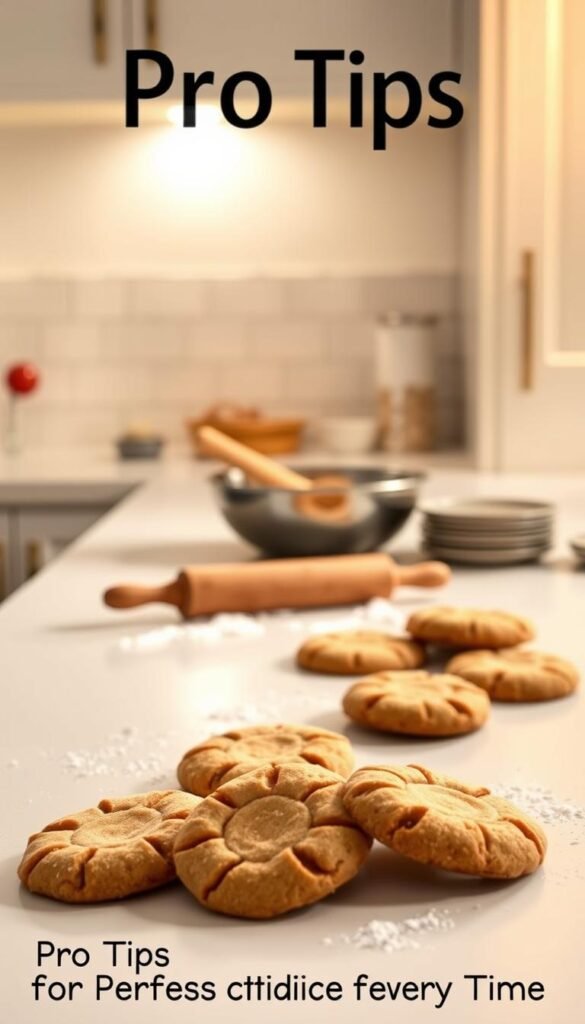
Control spread with chill and cool pans
Chill drop dough at least two hours to firm the fats. Rest pinwheel logs the same way so slices bake with neat edges.
Always portion dough onto a cool cookie sheet lined with parchment. A warm baking sheet can melt the dough and cause early spreading.
Pick sprinkles and finish on top
Use jimmies or confetti sprinkles; they rarely bleed in dough. Avoid small nonpareils that can leak color during baking.
Press candy accents onto warm tops right after baking so they stick without extra icing. Keep portions even and leave space between pieces for airflow and even baking.
| Tip | Why it matters | Quick action |
|---|---|---|
| Room temperature ingredients | Creates smooth emulsion and consistent crumb | Warm butter 30–60 min at room temp |
| Chill dough | Controls spread, firms fats for sharp edges | Rest drops 2+ hours; logs 1+ hour |
| Cool baking sheet + parchment | Prevents premature melting and slumping | Use fresh sheet each tray; line with parchment |
| Choose sprinkles that won’t bleed | Keeps colors true and designs clean | Use jimmies/confetti; add nonmelting accents on top |
Variations: One Dough, Many Spooky Looks
One batch of basic dough can transform into three distinct looks with only a few extra steps.
Start by making the base dough once, then split, tint, or fold in mix-ins to get different textures and finishes.
M&M and sprinkle-studded chewy cookies
Fold candy and sprinkles into chilled dough, scoop evenly, and bake at 350°F until edges set and centers stay soft.
Tip: Chill at least 2 hours for minimal spread and a tender bite.
No-spread sugar cookie cut-outs for sharp shapes
Roll the sugar cookie dough 1/4–1/2 inch thick, use cookie cutters that match your theme, and bake 7–11 minutes at 350°F.
Add a touch of almond or vanilla for flavor before chilling and cutting.
Pinwheel slice-and-bake cookies with gel coloring
Divide dough, tint one half with gel for bold colors, stack, roll into a tight log, chill, then slice 1/4–1/2 inch thick.
Bake at 325°F for 13–15 minutes. If layers stick, chill briefly on parchment and square the edges for neat spirals.
| Variation | Key move | Bake temp | Best finish |
|---|---|---|---|
| Chewy M&M drops | Fold in candy & sprinkles; chill | 350°F ~12 min | Soft center, rustic top |
| No-spread cut-outs | Roll to 1/4–1/2″, use cookie cutters | 350°F 7–11 min | Sharp edges for icing |
| Pinwheel slices | Layer colored dough, roll tight | 325°F 13–15 min | Vivid spiral rounds |
easy halloween cookies: Time, Temperature, and Yields
Timing and thickness matter most when you want consistent results across different cookie styles. Follow clear bake minutes and oven settings so trays come out uniform every time.

Bake times by style
Cut-outs: Roll sugar cookie dough 1/4–1/2 inch thick. Bake at 350°F for 7–11 minutes depending on size.
Drop: Portion scoops onto a parchment paper-lined baking sheet and bake at 350°F for about 12 minutes, until edges turn golden.
Pinwheels: Slice 1/4–1/2 inch thick and bake at 325°F for 13–15 minutes; they should not brown heavily to keep colors bright.
Practical notes and yields
- Space portions about 2 inches apart on the sheet for even heat flow.
- Smaller cutters increase yield; thicker slices reduce counts but give a softer bite.
- If cookies brown too fast, drop the temperature slightly and add a minute; if underdone, add 1–2 minutes and recheck.
- Chilled dough often needs the high end of the minutes range; room-temp dough bakes faster.
- Allow carryover cooking on the sheet for 1–2 minutes before moving to a rack.
| Style | Typical minutes | Oven temp | Key tip |
|---|---|---|---|
| Cut-outs | 7–11 minutes | 350°F | Roll 1/4–1/2″ for consistent bake |
| Drop | ~12 minutes | 350°F | Use parchment paper and space 2″ apart |
| Pinwheels | 13–15 minutes | 325°F | Chill log; slice 1/4–1/2″ to hold colors |
Storage, Freezing, and Make-Ahead
A clear storage plan keeps your batches tasting bakery‑fresh for days. Use airtight containers to hold most baked goods at room temperature. Add a layer of parchment paper between stacked layers to protect decoration and prevent sticking.
Room temperature storage in airtight containers
Store drop style cookies in a sealed container at room for up to 5 days. Pinwheel slices keep well on the counter about a week; refrigerating can dry them, though they may last up to two weeks if wrapped tightly.
For decorated sugar cookies, let frosting crust before stacking. Place a paper towel inside the container to absorb excess moisture and keep a crisp snap.
Freeze dough logs or portions for future baking
Freeze scoopable dough or wrapped logs for 1–3 months. Label each package with the date and style so you can rotate stock.
Thaw wrapped dough at room temperature until sliceable or scoopable, then bake on a lined sheet following original directions.
Freezing baked cookies and quick thaw methods
Freeze fully cooled cookies flat in a single layer. Transfer to an airtight box with parchment paper separators for up to 2–3 months.
To refresh texture, bring cookies to room temperature or warm briefly in a low oven. Keep a small bowl of spare icing handy for quick touch‑ups after thawing.
- For parties: bake a day ahead and frost the morning of service.
- Rotate frozen dough inventory to avoid long storage.
- When refrigerating, wrap well and return to room temperature before serving for best texture.
Conclusion
Each recipe here focuses on repeatable steps so even busy hosts can serve standout treats with confidence. Use the chilled M&M-style drops at 350°F, no-spread sugar cookie rounds for sharp shapes at 350°F for 7–11 minutes, or gel-tinted pinwheels baked 13–15 minutes at 325°F.
Make-ahead options save time: freeze dough logs or baked trays, and refresh decorated pieces with a few touch-ups of frosting or vanilla glaze before serving.
Keep pro moves in mind — cream well, chill when needed, and bake on cool pans. Use jimmies or confetti sprinkles and press candy eyes onto warm tops for clean designs.
In short: this post gives a clear path to easy halloween cookies in three styles. Try one now and build a seasonal rotation that fits your time and taste.
